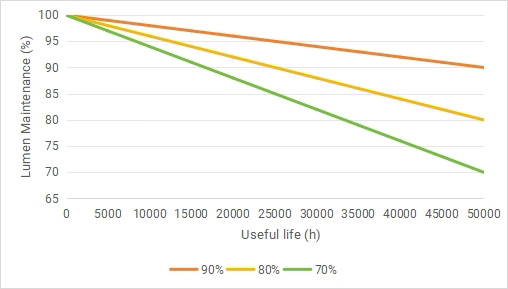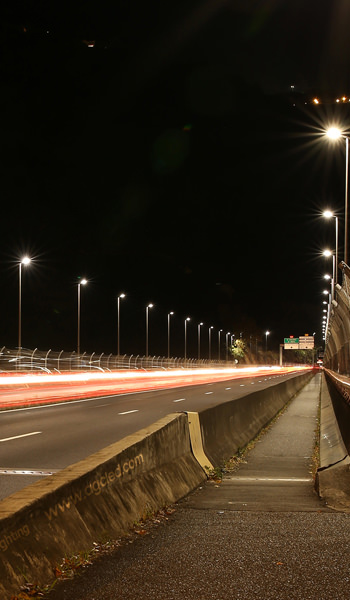The brightness, or luminous flux, of LEDs gradually decreases as they age. This is a normal process, but it’s important to maintain the right level of light output to ensure safety and proper visibility over the lifespan of the fixture. One common solution is to design a lighting system with higher initial brightness to account for this gradual loss. However, this can lead to wasted energy and increased costs, as the fixture may produce more light than needed, especially during the early years of its life.
As energy costs rise and resources become scarcer, efficient lighting solutions are more important than ever. How can this issue be addressed?
The answer lies in Constant Lumen Output (CLO), which remains constant light output over the life of lighting fixtures, eliminating the need for over-lighting and reducing energy waste.
What is constant light output?
Constant Light Output (CLO) technology helps address this lumen depreciation. It compensates lumen depreciation from the very start of a fixture’s service life. CLO runs the luminaire at a lower current initially and then increases the current output gradually. With CLO, the lighting fixture maintains a consistent lumen output throughout its lifespan. This means that the lighting fixtures last longer, are more energy-efficient, and reduce operating costs over the entire life.
Why constant light output matters
CLO is important because it can help us reduce energy consumption and maintenance costs. It also allows fewer fixtures to achieve the same light level. To understand it, let’s learn lumen depreciation first.
LEDs Lumen depreciation
Lumen depreciation is a natural phenomenon that occurs as LEDs degrade, typically due to the aging of materials or environmental factors. To achieve the desired light output at a specific point in the fixture's lifespan, we use the Lamp Lumen Maintenance Factor (LLMF) to assess its performance over time.
LLMF is a ratio that compares the light output of a lamp at a given moment to its initial output. Take the standard lifespan of a lighting system as 50,000 hours as an example. A “L80” rating means that after 50,000 hours of operation, the fixture retains at least 80% of its original luminous flux.

CLO compensates lumen depreciation
Since "L80" implies a 20% reduction in brightness over time, lighting systems are often designed to deliver 20% more light initially than is needed. However, this excess output leads to unnecessary energy consumption.
This is where Constant Light Output (CLO) technology comes into play. CLO optimizes the luminaire's power management by reducing the initial power load. During the early stages of the LED's life, the fixture operates at less than full power, gradually increasing the output current over time to counteract the natural decline in light output.

Benefits of CLO
With CLO, over-illumination is minimized. It also brings benefits including:
- Extended lifetime of the LED module
- Increased energy efficiency and reduced consumption
- Constant light levels over the lifetime of the luminaire
- Reduced maintenance costs
How does CLO technology work?
We’ve learned why Constant Light Output (CLO) matters in LED lighting, but how does it actually work?
CLO ensures that LED luminaires maintain consistent light levels throughout their entire lifespan. It achieves this through programmable drivers that gradually increase the power supplied to the LED over time. This compensates for the natural light depreciation that occurs as the LED ages, allowing the fixture to deliver steady brightness.
Typically, CLO systems rely on pre-programmed compensation curves, which predict the rate of light depreciation. Based on these curves, the system adjusts the power input to the fixture to offset the reduction in light output. As a result, it maintains constant lumen output over the life of the fixture.
Some advanced CLO systems also incorporate sensors that measure the actual light output. By monitoring this data, the system can detect real-time changes in light levels due to aging or other factors. This allows for immediate adjustments to the power supply, ensuring consistent brightness even as the LED's condition changes.
FAQ
Is CLO compatible with all types of lighting fixtures?
No, CLO technology is not compatible with all types of lighting fixtures. It is primarily designed for modern LED lighting solutions. Its compatibility also depends on the specific lighting fixture and the driver used.
Can CLO technology be retrofitted to existing lighting systems
CLO can often be retrofitted to existing lighting systems, but the feasibility depends on your type of existing fixtures, existing wiring, and costs.












